Characterization of Grid Lines Formed by Laser-Induced Forward Transfer and Effect of Laser Fluence on the Silver Paste Transformation
Abstract
1. Introduction
2. Materials and Methods
3. Results
3.1. Characterization
3.2. Effect of Laser Fluence on Cross-Sectional Morphology
4. Discussion
5. Conclusions
Author Contributions
Funding
Institutional Review Board Statement
Informed Consent Statement
Data Availability Statement
Conflicts of Interest
References
- Rehman, Z.U.; Yang, F.; Wang, M.; Zhu, T. Fundamentals and Advances in Laser-Induced Transfer. Opt. Laser Technol. 2023, 160, 109065. [Google Scholar] [CrossRef]
- del Campo, A.; Arzt, E. Fabrication Approaches for Generating Complex Micro- and Nanopatterns on Polymeric Surfaces. Chem. Rev. 2008, 108, 911–945. [Google Scholar] [CrossRef] [PubMed]
- Zhang, Y.; Liu, C.; Whalley, D. Direct-Write Techniques for Maskless Production of Microelectronics: A Review of Current State-of-the-Art Technologies. In Proceedings of the 2009 International Conference on Electronic Packaging Technology & High Density Packaging, Beijing, China, 10–13 August 2009; pp. 497–503. [Google Scholar]
- Vaezi, M.; Seitz, H.; Yang, S. A review on 3D micro-additive manufacturing technologies. Int. J. Adv. Manuf. Technol. 2013, 67, 1721–1754. [Google Scholar] [CrossRef]
- Florian, C.; Caballero-Lucas, F.; Fernández-Pradas, J.; Artigas, R.; Ogier, S.; Karnakis, D.; Serra, P. Conductive silver ink printing through the laser-induced forward transfer technique. Appl. Surf. Sci. 2015, 336, 304–308. [Google Scholar] [CrossRef]
- Mathews, S.A.; Charipar, N.A.; Auyeung, R.C.Y.; Kim, H.; Piqué, A. Laser Forward Transfer of Solder Paste for Microelectronics Fabrication. In Proceedings of the Photonics West—Lasers and Applications in Science and Engineering, San Francisco, CA, USA, 7–12 February 2015. [Google Scholar]
- Breckenfeld, E.; Kim, H.; Auyeung, R.; Charipar, N.; Serra, P.; Piqué, A. Laser-induced forward transfer of silver nanopaste for microwave interconnects. Appl. Surf. Sci. 2015, 331, 254–261. [Google Scholar] [CrossRef]
- Acciari, G.; Adamo, G.; Ala, G.; Busacca, A.; Caruso, M.; Giglia, G.; Imburgia, A.; Livreri, P.; Miceli, R.; Parisi, A.; et al. Experimental Investigation on the Performances of Innovative PV Vertical Structures. Photonics 2019, 6, 86. [Google Scholar] [CrossRef]
- Hörteis, M.; Glunz, S. Fine line printed silicon solar cells exceeding 20% efficiency. Prog. Photovolt. Res. Appl. 2008, 16, 555–560. [Google Scholar] [CrossRef]
- Gizachew, Y.; Escoubas, L.; Simon, J.; Pasquinelli, M.; Loiret, J.; Leguen, P.; Jimeno, J.; Martin, J.; Apraiz, A.; Aguerre, J. Towards ink-jet printed fine line front side metallization of crystalline silicon solar cells. Sol. Energy Mater. Sol. Cells 2011, 95, S70–S82. [Google Scholar] [CrossRef]
- Li, Q.; Grojo, D.; Alloncle, A.-P.; Chichkov, B.; Delaporte, P. Digital laser micro- and nanoprinting. Nanophotonics 2019, 8, 27–44. [Google Scholar] [CrossRef]
- Pospischil, M.; Kuchler, M.; Klawitter, M.; Lacmago, I.; Tepner, S.; Efinger, R.; Linse, M.; Witt, D.; Gutscher, S.; Brand, A.; et al. High Speed Dispensing—A High-Throughput Metallization Technology for >21% PERC Type Solar Cells. In Proceedings of the 32nd European Photovoltaic Solar Energy Conference and Exhibition, Munich, Germany, 20–24 June 2016; pp. 403–406. [Google Scholar] [CrossRef]
- Pospischil, M.; Riebe, T.; Jimenez, A.; Kuchler, M.; Tepner, S.; Geipel, T.; Ourinson, D.; Fellmeth, T.; Breitenbücher, M.; Buck, T.; et al. Applications of parallel dispensing in PV metallization. AIP Conf. Proc. 2019, 2156, 020005. [Google Scholar] [CrossRef]
- Morales, M.; Chen, Y.; Muñoz, D.; Lauzurica, S.; Molpeceres, C. High volume transfer of high viscosity silver pastes using laser direct-write processing for screen printing of c-Si cells. In Proceedings of the Laser-based Micro- and Nanoprocessing IX, San Francisco, CA, USA, 1 March 2015; Volume 9351, p. 93510B. [Google Scholar] [CrossRef]
- Strauch, T.; Demant, M.; Lorenz, A.; Haunschild, J.; Rein, S. Two Image Processing Tools to Analyse Alkaline Texture and Contact Finger Geometry in Microscope Images. In Proceedings of the 29th European Photovoltaic Solar Energy Conference and Exhibition, Amsterdam, The Netherlands, 23–25 September 2014; pp. 1132–1137. [Google Scholar] [CrossRef]
- Zhang, Y.; Tian, C.; Yu, Y.; He, X.; Bian, Y.; Li, S.; Yu, G. Morphological Characteristics and Printing Mechanisms of Grid Lines by Laser-Induced Forward Transfer. Metals 2022, 12, 2090. [Google Scholar] [CrossRef]
- Munoz-Martin, D.; Brasz, C.; Chen, Y.; Morales, M.; Arnold, C.; Molpeceres, C. Laser-induced forward transfer of high-viscosity silver pastes. Appl. Surf. Sci. 2016, 366, 389–396. [Google Scholar] [CrossRef]
- Chen, Y.; Munoz-Martin, D.; Morales, M.; Molpeceres, C.; Sánchez-Cortezon, E.; Murillo-Gutierrez, J. Laser Induced Forward Transfer of High Viscosity Silver Paste for New Metallization Methods in Photovoltaic and Flexible Electronics Industry. Phys. Procedia 2016, 83, 204–210. [Google Scholar] [CrossRef]
- Sopeña, P.; Fernández-Pradas, J.; Serra, P. Laser-induced forward transfer of conductive screen-printing inks. Appl. Surf. Sci. 2020, 507, 145047. [Google Scholar] [CrossRef]
- Munoz-Martin, D.; Chen, Y.; Morales, M.; Molpeceres, C. Overlapping Limitations for ps-Pulsed LIFT Printing of High Viscosity Metallic Pastes. Metals 2020, 10, 168. [Google Scholar] [CrossRef]
- Unger, C.; Gruene, M.; Koch, L.; Koch, J.; Chichkov, B. Time-resolved imaging of hydrogel printing via laser-induced forward transfer. Appl. Phys. A 2011, 103, 271–277. [Google Scholar] [CrossRef]
- Sanchez-Aniorte, M.I.; Mouhamadou, B.; Alloncle, A.P.; Sarnet, T.; Delaporte, P. Laser-induced forward transfer for improving fine-line metallization in photovoltaic applications. Appl. Phys. Mater. Sci. Process. 2016, 122, 595. [Google Scholar] [CrossRef]
- Lossen, J.; Matusovsky, M.; Noy, A.; Maier, C.; Bähr, M. Pattern Transfer Printing (PTPTM) for c-Si Solar Cell Metallization. Energy Procedia 2015, 67, 156–162. [Google Scholar] [CrossRef]
- Adrian, A.; Rudolph, D.; Willenbacher, N.; Lossen, J. Finger Metallization Using Pattern Transfer Printing Technology for c-Si Solar Cell. IEEE J. Photovolt. 2020, 10, 1290–1298. [Google Scholar] [CrossRef]
- Fabbro, R.; Fournier, J.; Ballard, P.; Devaux, D.; Virmont, J. Physical study of laser-produced plasma in confined geometry. J. Appl. Phys. 1990, 68, 775–784. [Google Scholar] [CrossRef]
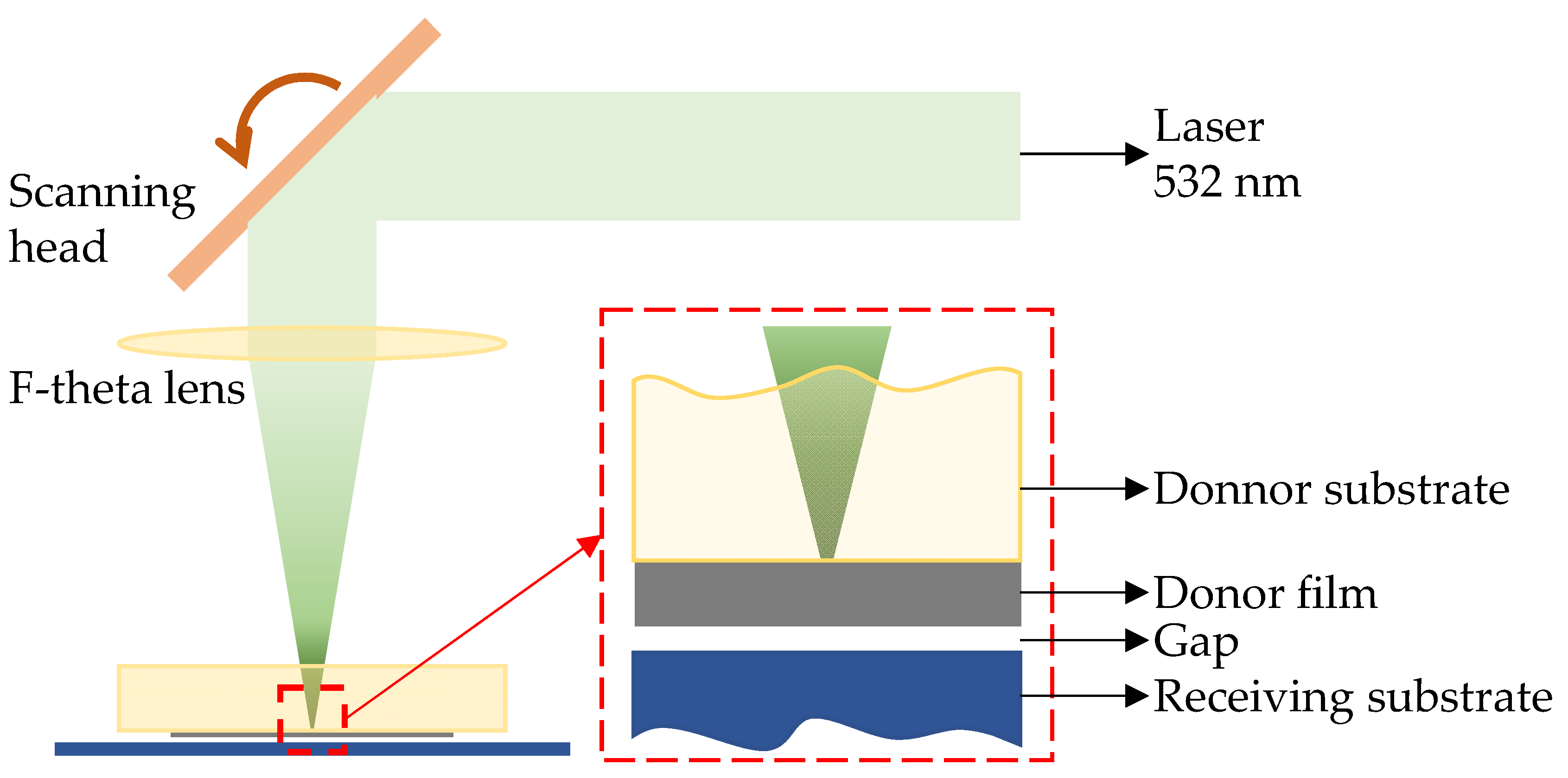


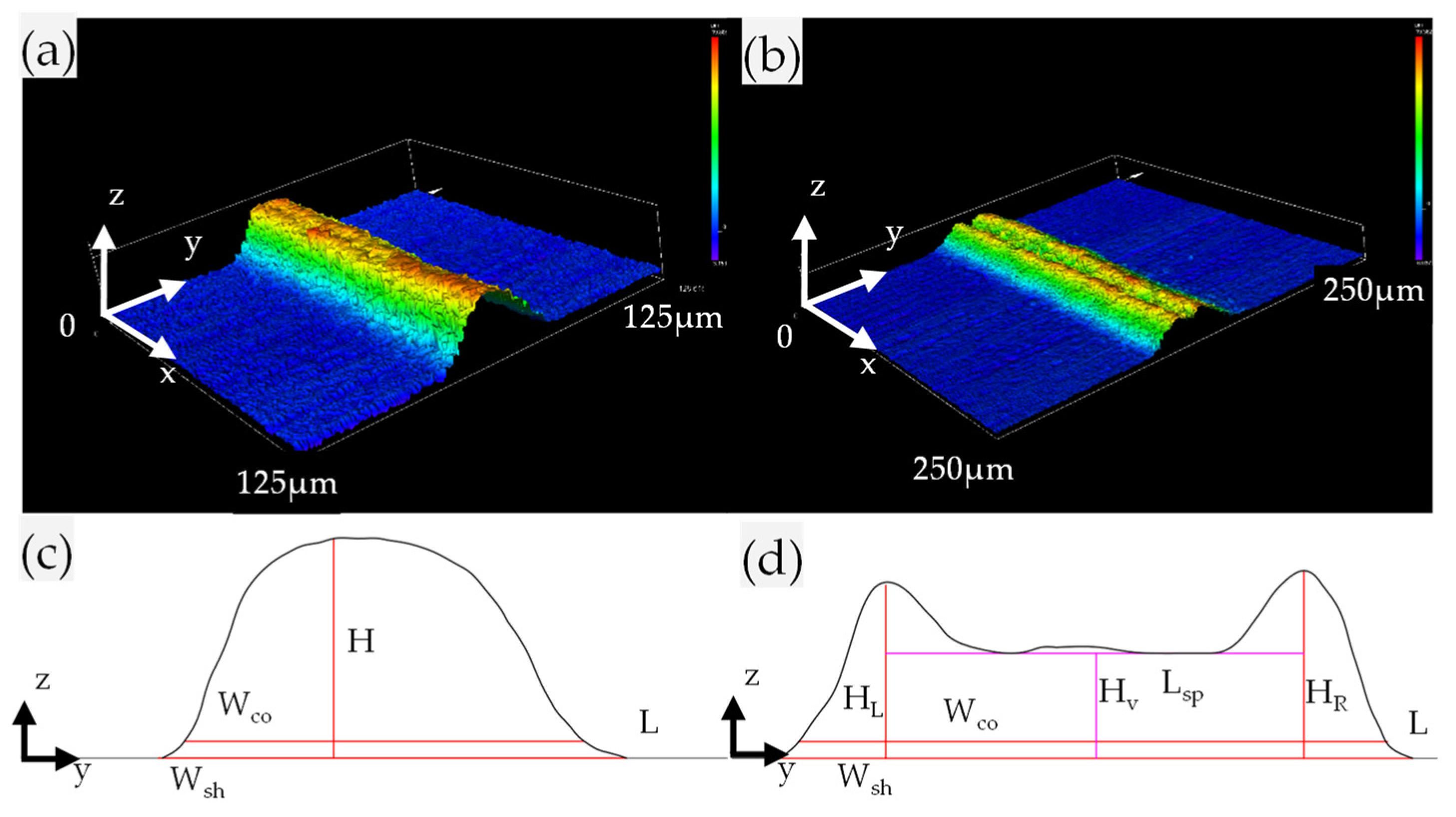

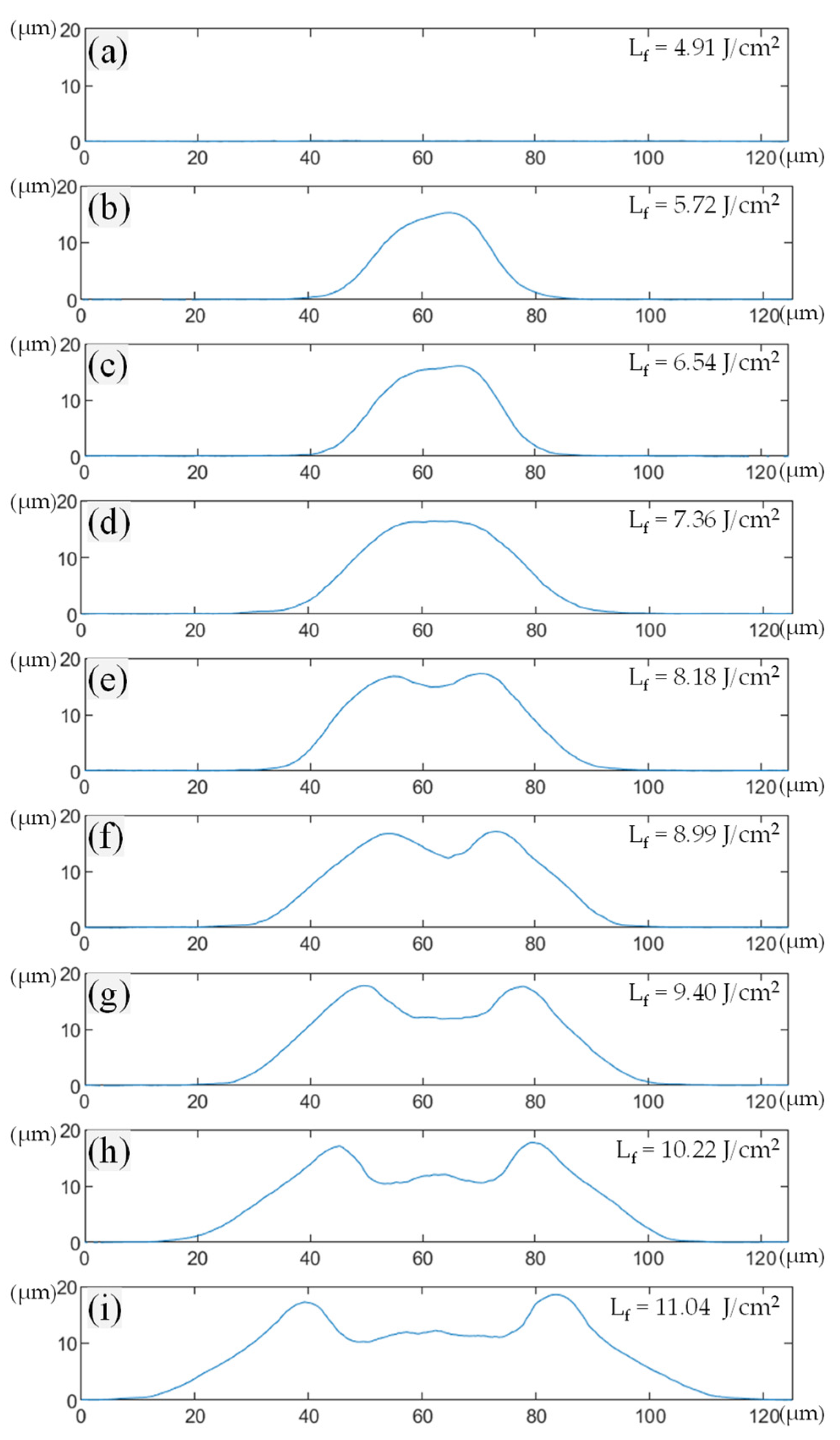
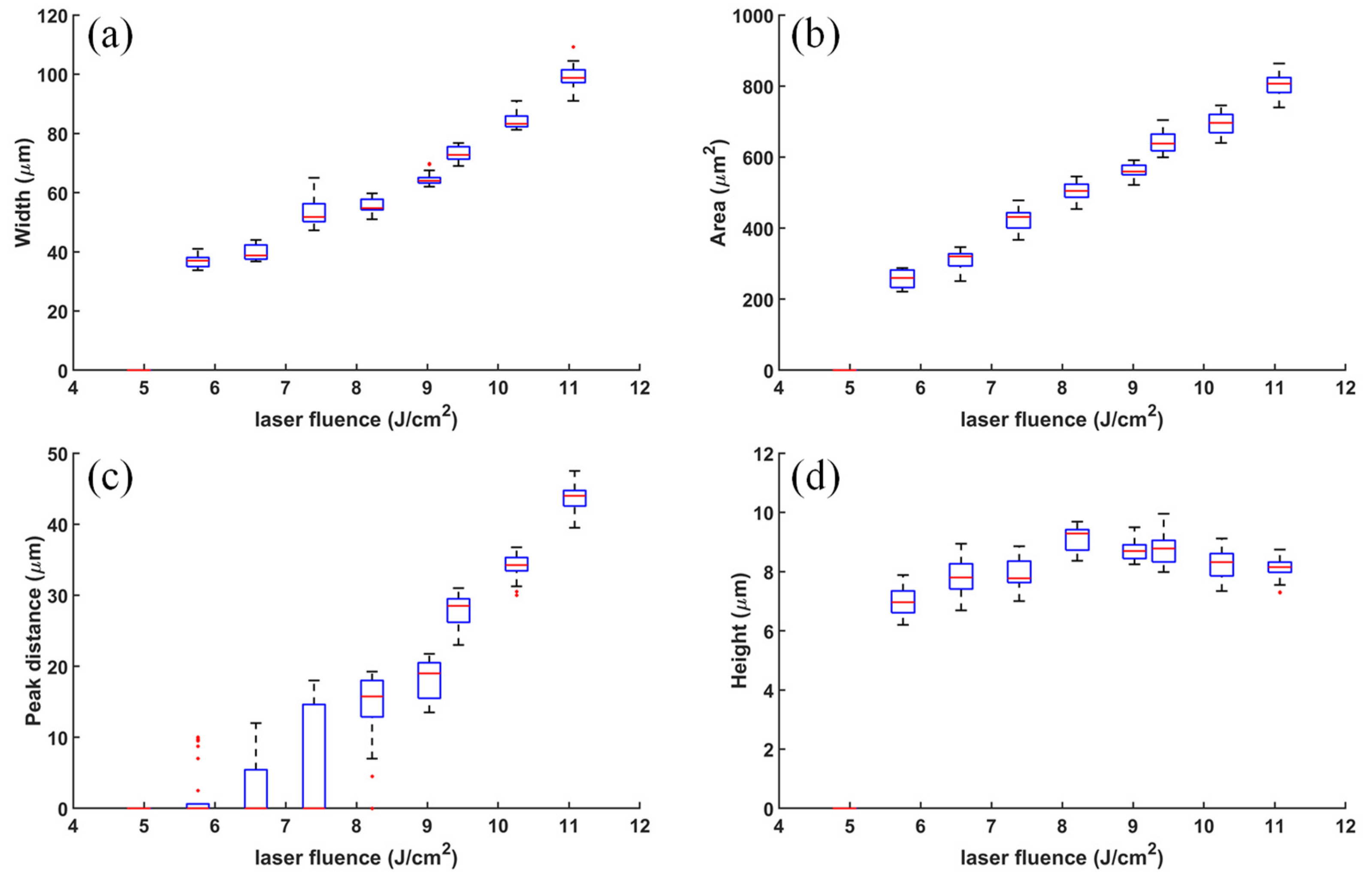

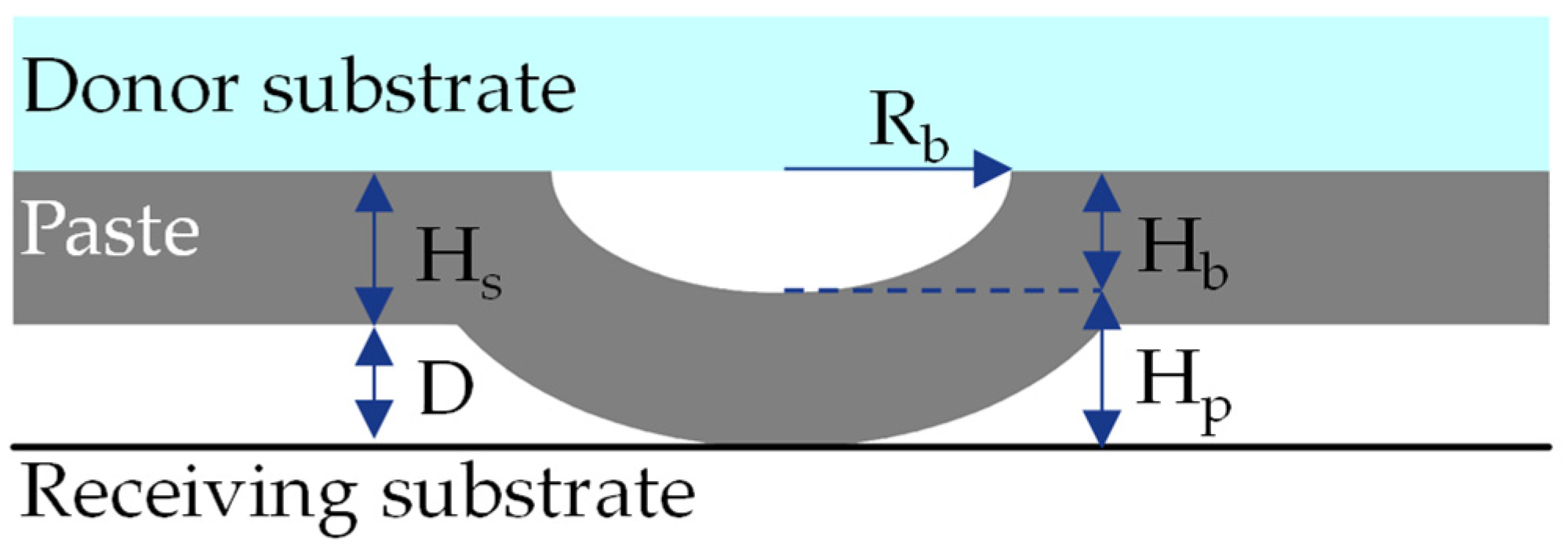
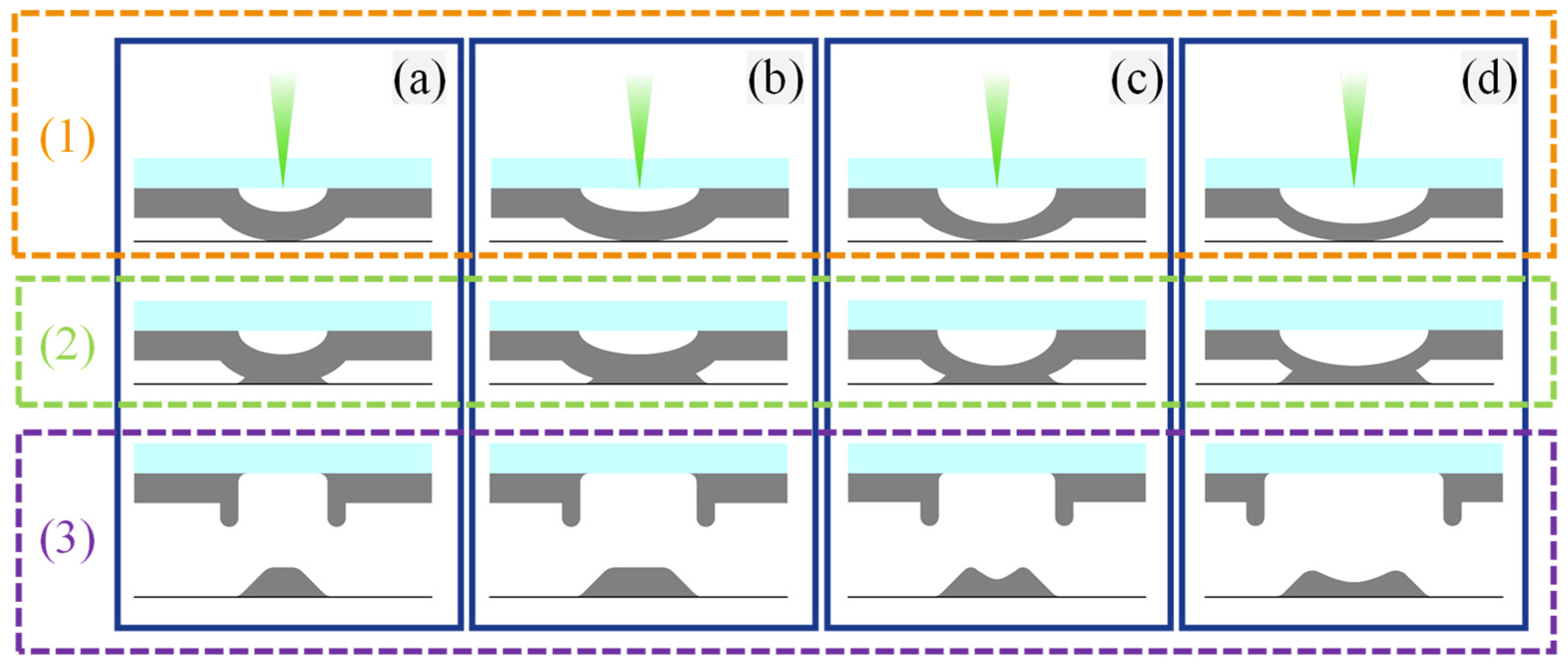
| Properties | Value |
|---|---|
| Solid content | 91.68 wt% |
| Particle size | <3~5 μm |
| Viscosity | 157 pa·s(20 rpm/3 min) |
| Morphologies | Single-Peak | Double-Peak |
|---|---|---|
| Horizontal baseline | L | L |
| Average shading line-width | Wsh | Wsh |
| Conducting line-width | Wco | Wco |
| Line height | H | HL; HR |
| Cross-sectional area | Acrsct | Acrsct |
| Aspect ratio | AR | AR |
| Valley height | / | Hv |
| Peak separation | / | Lsp |
Disclaimer/Publisher’s Note: The statements, opinions and data contained in all publications are solely those of the individual author(s) and contributor(s) and not of MDPI and/or the editor(s). MDPI and/or the editor(s) disclaim responsibility for any injury to people or property resulting from any ideas, methods, instructions or products referred to in the content. |
© 2023 by the authors. Licensee MDPI, Basel, Switzerland. This article is an open access article distributed under the terms and conditions of the Creative Commons Attribution (CC BY) license (https://creativecommons.org/licenses/by/4.0/).
Share and Cite
Yu, Y.; Zhang, Y.; Tian, C.; He, X.; Li, S.; Yu, G. Characterization of Grid Lines Formed by Laser-Induced Forward Transfer and Effect of Laser Fluence on the Silver Paste Transformation. Photonics 2023, 10, 717. https://doi.org/10.3390/photonics10070717
Yu Y, Zhang Y, Tian C, He X, Li S, Yu G. Characterization of Grid Lines Formed by Laser-Induced Forward Transfer and Effect of Laser Fluence on the Silver Paste Transformation. Photonics. 2023; 10(7):717. https://doi.org/10.3390/photonics10070717
Chicago/Turabian StyleYu, Yucui, Yanmei Zhang, Chongxin Tian, Xiuli He, Shaoxia Li, and Gang Yu. 2023. "Characterization of Grid Lines Formed by Laser-Induced Forward Transfer and Effect of Laser Fluence on the Silver Paste Transformation" Photonics 10, no. 7: 717. https://doi.org/10.3390/photonics10070717
APA StyleYu, Y., Zhang, Y., Tian, C., He, X., Li, S., & Yu, G. (2023). Characterization of Grid Lines Formed by Laser-Induced Forward Transfer and Effect of Laser Fluence on the Silver Paste Transformation. Photonics, 10(7), 717. https://doi.org/10.3390/photonics10070717






